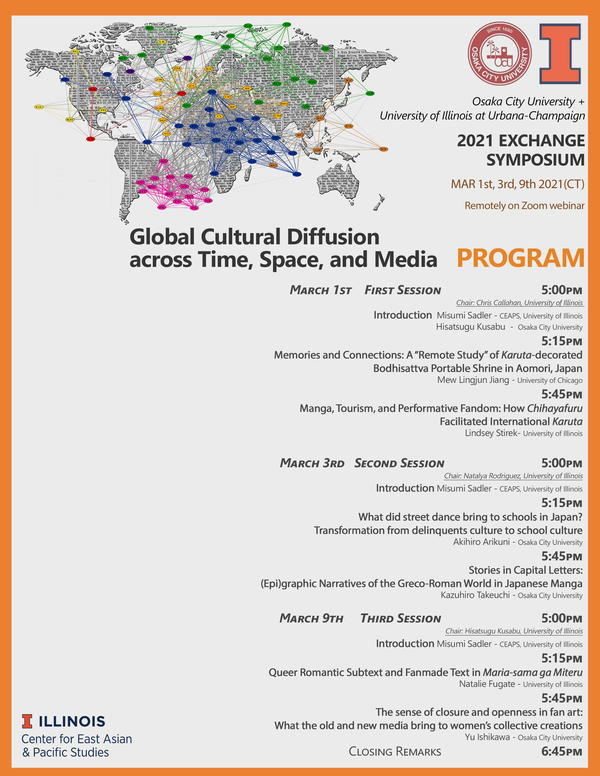Illinois - Osaka City University Exchange Symposium Series 2021: “Global Cultural Diffusion across Time, Space, and Media” (Session 2)

- Sponsor
- Center for East Asian and Pacific Studies
- Registration
- Registration
- Contact
- Center for East Asian and Pacific Studies
- ceaps@illinois.edu
- Views
- 98
- Originating Calendar
- CEAPS Events Calendar
The Center for East Asian and Pacific Studies at University of Illinois at Urbana-Champaign and The Urban-Culture Research Center (UCRC) at Osaka City University (OCU) Present
Illinois - Osaka City University Exchange Symposium Series 2021: “Global Cultural Diffusion across Time, Space, and Media”
March 1-9, 2021, Virtual
Session 2: “Cultural Diffusion across Social Scenes”
Wednesday, March 3, 2021, 5-6:45 pm US Central Time
Session Chair: Natalya Rodriguez (EALC, University of Illinois)- 5:00-5:10 pm
Introduction
Misumi Sadler (CEAPS, University of Illinois) - 5:15-5:45 pm
Akihiro Arikuni (Doctoral Student in Sociology, OCU)
“What did street dance bring to schools in Japan? Transformation from delinquents culture to school culture” - 5:45-6:15 pm
Kazuhiro Takeuchi (PhD in Classics, University of Athens: UCRC fellow, teaching Ancient History at the University of Kobe)
“Stories in Capital Letters: (Epi)graphic Narratives of the Greco-Roman World in Japanese Manga” - 6:15-6:45 pm
Q & A
ABSTRACTS
What did street dance bring to schools in Japan? Transformation from delinquent culture to school culture
by Akihiro Arikuni, Doctoral Student in Sociology, OCUThis research introduces a case study involving street dancing. Interestingly, street dancing is now taught as part of compulsory school education, which seems to suggest that dancing may increasingly influence young people. This also shows the potential for significant cultural misunderstandings as we introduce foreign practices, such as dance, into school education.
Hip-hop culture, which includes the origin of street dance, has created a negative image of hip-hop culture, including social issues such as poverty and crime. Furthermore, in Japan, street dancing is normally practiced by school delinquents. This does not help educators look at dancing positively. In some areas, special laws prohibit street dancers. Such factors deterred Japanese schools from incorporating street dancing into their curricula in the past. However, by trying to hide the historical and socially negative side of street dancing and emphasizing what appears to be good and agreeable, street dancing has been accepted in the school system and Japanese society in general. This appears, at least to me, to be a contradiction.
In this presentation, I will examine street dancing as a compulsory component in Japanese school education and the various issues surrounding compulsory dance in that context. While introducing foreign practices, such as dancing, into school education, major cultural misunderstandings can occur.
Stories in Capital Letters: (Epi)graphic Narratives of the Greco-Roman World in Japanese Manga
by Kazuhiro TAKEUCHI, PhD in Classics, University of Athens: UCRC fellow, teaching Ancient History at the University of KobeNew graphic representation of the Greco-Roman world has won an audience in Japanese manga. Recent authors are focusing on the characters who themselves were in the position to write down words, read stories, and keep archives in ancient times. Specifically, Historiē by Hitoshi Iwaaki (2003-) is a story of Eumenes of Cardia, secretary to Philip II and Alexander the Great of Macedon, and Plinius by Mari Yamazaki and Miki Tori (2014-) makes to appear Eukles as clerk to Pliny the Elder. In a word, both works describe the history and at the same time, their characters describe history using a wax tablet with a stylus. Both manga authors are more effectively bringing in the scene the original Greek and Latin texts as written on papyruses, inscribed on stone stelai, and scribbled on walls. Those texts are intentionally written in all capital letters, just as the ancient texts used to be. While it may be beyond general readers, the representation of uppercase letters can well place the story in the antiquity as well as give reality to the historiography. In this way, such manga would be successful to introduce an audience into the world, which seems to be the past. In this presentation, I shed light on the (epi)graphic device that the manga authors carefully and deliberately embedded in their narratives of Greek and Roman history, focusing on the meaning of capitalized letters used on papyrus scrolls, honorary and funeral monuments, shield, and building walls.
- 5:00-5:10 pm